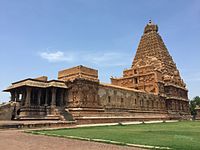Raja raja chola I ( Arts and architecture | Coins )
Arts and architecture
Raja Raja Chola embarked on a mission to recover the hymns after hearing short excerpts of Thevaram in his court.He sought the help of Nambi Andar Nambi. It is believed that by divine intervention Nambi found the presence of scripts, in the form of cadijam leaves half eaten by white ants in a chamber inside the second precinct in Thillai Nataraja Temple, Chidambaram. The brahmanas (Dikshitars) in the temple opposed the mission, but Rajaraja intervened by consecrating the images of the saint-poets through the streets of Chidambaram. Rajaraja thus became to be known as Tirumurai Kanda Cholan meaning one who saved the Tirumurai.Thus far Shiva temples only had images of god forms, but after the advent of Rajaraja, the images of the Nayanar saints were also placed inside the temple. Nambi arranged the hymns of three saint poets Sambandar, Appar and Sundarar as the first seven books, Manickavasagar's Tirukovayar and Tiruvacakam as the 8th book, the 28 hymns of nine other saints as the 9th book, the Tirumandiram of Tirumular as the 10th book, 40 hymns by 12 other poets as the 10th book, Tirutotanar Tiruvanthathi - the sacred anthathi of the labours of the 63 nayanar saints and added his own hymns as the 11th book. The first seven books were later called as Tevaram, and the whole Saiva canon, to which was added, as the 12th book, Sekkizhar's Periya Puranam (1135) is wholly known as Tirumurai, the holy book. Thus Saiva literature which covers about 600 years of religious, philosophical and literary development.
Brihadisvara Temple
In 1010, Raja Raja built the Brihadisvara Temple in Thanjavur dedicated to Lord Shiva. The temple and the capital acted as a center of both religious and economic activity. It is also known as Periya Kovil, RajaRajeswara Temple and Rajarajeswaram. It is one of the largest temples in India and is an example of Dravidian architecture during the Chola period. The temple turned 1000 years old in 2010.[67] The temple is part of the UNESCO World Heritage Site known as the "Great Living Chola Temples", with the other two being the Gangaikonda Cholapuram and Airavatesvara temple.
The vimanam (temple tower) is 216 ft (66 m) high and is the tallest in the world. The Kumbam (the apex or the bulbous structure on the top) of the temple is carved out of a single rock and weighs around 80 tons. There is a big statue of Nandi (sacred bull), carved out of a single rock measuring about 16 feet long and 13 feet high at the entrance. The entire temple structure is made out of granite, the nearest sources of which are about 60 km to the west of temple. The temple is one of the most visited tourist attractions in Tamil Nadu.
Coins
Before the reign of Raja Raja Chola the Chola coins had on the obverse the tiger emblem and the fish and bow emblems of the Pandya and Chera Dynasties and on the reverse the name of the King. But during the reign of Raja Raja Chola appeared a new type of coins. The new coins had on the obverse the figure of the standing king and on the reverse the seated goddess. The coins spread over a great part of South India and were also copied by the kings of Sri Lanka.

Comments
Post a Comment